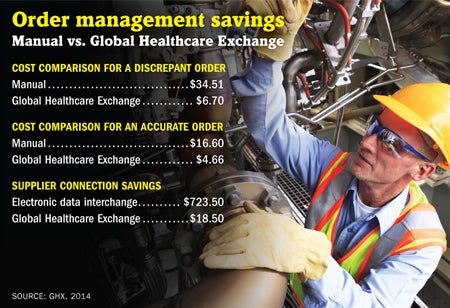Honing a vision to manage engineering supply costs
 Over the past decade, hospitals have stepped up efforts to better manage supply chain spending. Typically, the predominant focus has been on medical-surgical products and the most expensive medical devices. Significant savings have been achieved through close collaboration among materials managers, surgeons and other clinical leaders and by automating nearly all areas of product procurement.
Over the past decade, hospitals have stepped up efforts to better manage supply chain spending. Typically, the predominant focus has been on medical-surgical products and the most expensive medical devices. Significant savings have been achieved through close collaboration among materials managers, surgeons and other clinical leaders and by automating nearly all areas of product procurement.
Now, some supply chain leaders are broadening their focus. McLeod Health, a five-hospital integrated delivery network in Florence, S.C., has created a vision for implementing the same sorts of parameters and best practices for the organization's engineering department as it has demonstrated successfully in its clinical supply chain.
The program, which is in its early stages, will focus on such areas as product standardization, consistent use of electronic procurement, utilizing a supply chain data exchange to capture and better analyze costs and product usage patterns, as well as other tactics.
"As we've been focused on improving operational efficiencies in the hospital across our system, engineering can't be forgotten," says Dale Locklair, vice president of procurement and construction at McLeod Health. "We believe we're on a journey and as we take on the engineering aspect of it, we think those opportunities represent real savings to the hospital system and ultimately to our patients."
One way Locklair plans to achieve these savings is through consistent adherence to electronic procurement of products. He notes that there is significant disparity in how engineering department products are purchased and managed, with a heavy emphasis on vendor-managed inventory. The plan is to automate the procurement process wherever practical.
"We are working to set up our inventory so that when a work order is issued for an item that requires a part to be pulled out of stock that there will be a minimum and maximum value and a product automatic replenishment level set for those items. When a threshold level is reached, the system automatically will kick out a replenishment order," Locklair says.
As simple as this may sound, it will take significant collaboration with internal supply chain leaders and vendors serving McLeod Health. Elsewhere, Locklair and his team will focus on collaborating with the engineering department on product standardization. The aim is to identify standards for heavy equipment replacement for such systems as boilers, chillers, generators and air-handling units.
"We would standardize on one manufacturer and one manufacturer's model number as much as possible," Locklair explains, adding that this approach would lead to standardizing equipment training and replacement parts across the health system. This way, for example, as existing air-handling units reach the end of their useful lives, the replacement system would be purchased according to the specification standards.
A key to making this program work will be electronically exchanging purchasing information through the Global Healthcare Exchange (GHX), database, Louisville, Colo.
"You've got to get your contracts on an electronic exchange, because it is very difficult to manage this information manually. When you think about the number of SKUs that an engineering department would manage, you must have that loaded into your materials management information system. You must have your contracts loaded for pricing and you must have a way to validate pricing when you issue a requisition," Locklair says.
Karen Conway, executive director of industry relations at GHX, says for medical-surgical products, hospitals save an average of $30 per purchase order by automating the process; the savings can be even higher for engineering. Automating the process also enables matching the PO to the supplier order confirmation to help eliminate order discrepancies.
"Where the real value comes in is when you can start getting data electronically regarding your purchases, including what you are buying, from whom, in what quantities and at what price. Then you start to better understand your demand and can start improving your contracting," Conway says.
Making this transition will take time, but Locklair hopes there will be significant progress sometime in 2015. "We're by no means there yet," he cautions. "We believe we're on a journey and it's a constant state of improvement."
By Bob Kehoe, associate publisher of Health Facilities Management.




